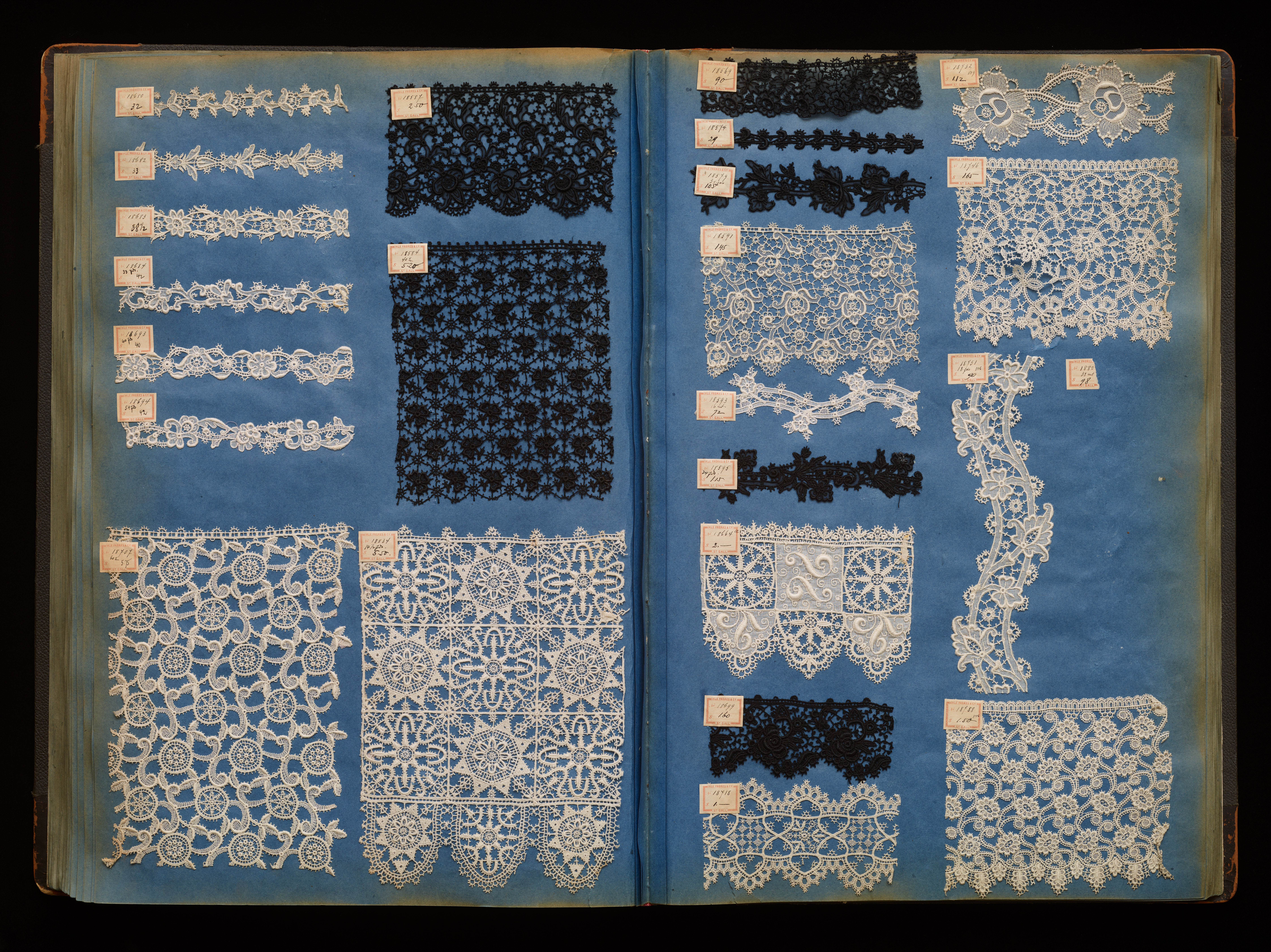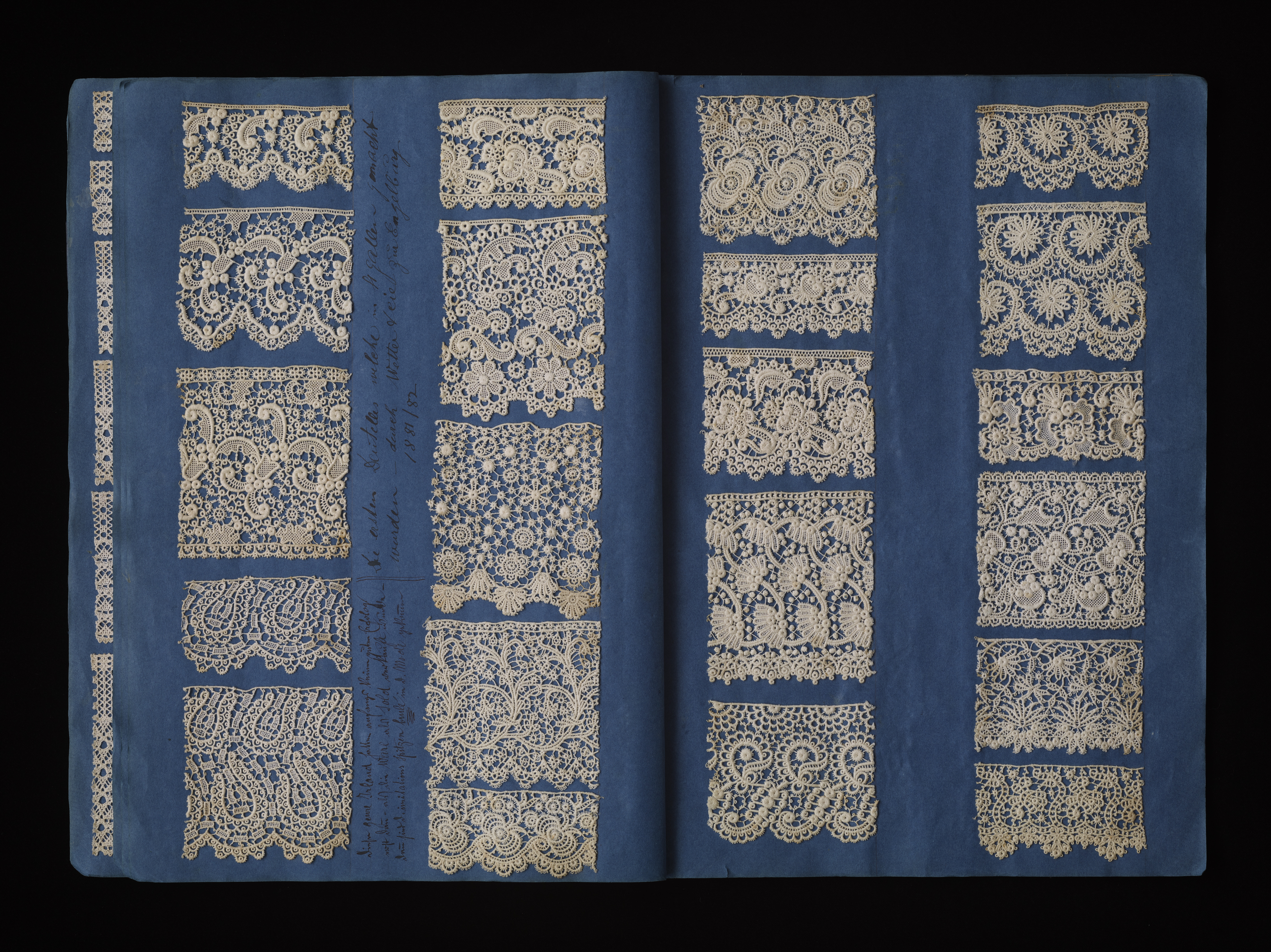A New York Times best art book of 2022!
Emma Cormack —

Now on view at Bard Graduate Center Gallery in New York, the exhibition Threads of Power: Lace from the Textilmuseum St. Gallen and the accompanying catalogue trace the five-century history of European lace.1 Drawing on the collection of the Textilmuseum St. Gallen, the installation of approximately 200 objects focuses on handmade techniques developed in France, Flanders, and on the Italian peninsula, as well as on a type of machine-made lace that originated in St. Gallen and the surrounding region of eastern Switzerland in the late nineteenth century. Often referred to as “chemical lace,” “Swiss lace,” “embroidered lace,” or “guipure lace,” this product was developed by Swiss manufacturers in the early 1880s. It involves stitching motifs on a fabric ground using an embroidery machine and then dissolving that base in a chemical bath, leaving only the embroidered design.
St. Gallen has been an important center of textile production since the fifteenth century. Located on the southwestern edge of Lake Constance, the city sits approximately 2,300 feet above sea level with a humid climate that in the early modern period provided fertile ground for the production of high-quality linen that was exported throughout Europe.2 At the beginning of the nineteenth century, St. Gallen was the trading center for a local rural industry in which many women hand embroidered cotton fabrics destined primarily for export. By the mid-century, the invention of machine technology that enabled the simultaneous production of stitched motifs increased output and in the 1880s, St. Gallen manufacturers discovered a variety of ways to produce openwork embroideries through a chemical process that resulted in openwork products often referred to in German as “Aetzstickerei” (etched embroideries). These processes could replicate styles of handmade lace with greater speed and efficiency. Between 1907 and 1918, machine-made embroideries were the top export in Switzerland, with a record 210 million francs exported in 1912.3 Following the Civil War, the United States was a primary consumer of goods produced in the region, and even following a severe crisis in the Swiss industry during World War I, connections between St. Gallen and New York and New Jersey, in particular, persisted.

The success of chemical lace production relied on the development of the hand-embroidery machine, an invention generally credited to Josué Heilmann (Swiss, 1796–1848) in Mulhouse, France in 1828.4 This machine was operated using a hand pantograph patterning device, a hand crank, and foot pedals. Seated at the pantograph, the operator relied on an enlarged technical drawing at their side to guide the machine to the precise location of each stitch marked on the drawing.5 A piece of woven fabric was suspended vertically and held taut on the main length of the device. Equidistant and located on opposite sides of this textile, two rows of pincers on rollers moved back and forth, controlled by the foot pedals. The pincers clamped center-threaded needles that, prompted by the operator, would pass through the fabric to make each individual stitch. Heilmann’s machine owes its success to the fact that it could faithfully copy the embroidery stitches produced by a human hand and it multiplied this act of stitching with a single needle and thread, therefore improving both production speed and cost efficiency. Early products were typically white embroidery on a woven ground, but the technology also enabled embroidery stitches on a mesh ground, producing lace-like textiles.6 Building on these technological advancements, it was the Schiffli machine and a series of experiments in the last quarter of the nineteenth century that helped propel the Swiss machine lace industry.
The Schiffli machine was invented in 1863 by Isaac Groebli (Swiss, 1822–1917) and evolved from the hand-embroidery machine technology. In its design the Schiffli retained the pantograph and hand crank of the earlier iteration and combined these elements with the domestic sewing machine’s two-thread system.7 The Schiffli could produce embroideries at a much faster rate and by varying the spacing of each stitch could create a variety of designs despite being limited to making lockstitches.8 It was Swiss manufacturer Charles Wetter-Rüesch (1857–1921) who was the first to successfully produce what is known as chemical lace, building on the inadvertent discovery by Jakob Sutter that silk could be dissolved completely in a chlorine solution. Wetter-Rüesch instead relied on sodium hydroxide (caustic soda) to remove the base fabric of his embroideries, worried about the harmful effects of workers in the industry using chlorine for large-scale production.9 In combination with the Schiffli technology, this revolutionary discovery enabled Swiss manufacturers (and their competitors in Plauen, Germany, and Vorarlberg in Austria) to faithfully reproduce the effects of handmade lace. From a distance, these chemical laces were convincing imitations, but close inspection reveals a slightly fuzzy effect and small, closely spaced zigzag lockstitches rather than the buttonhole stitches of handmade needle lace.

A significant portion of the goods made on embroidery machines in the St. Gallen region was destined for American consumers. The United States was the largest importer of these embroideries and chemical laces, with exports from St. Gallen totalling $67,989 in 1864; $1,343,744 in 1870; $4,351,995 in 1880; $7,247,952 in 1890; $7,389,924 in 1900; and $15,981,168 in 1906.10 St. Gallen products also appeared frequently in the American fashion press, with Swiss manufacturers advertising in Vogue and trade publications such as Women’s Wear Daily chronicling new developments and shifts in production. However, the industry was volatile, and faced downturns following the American financial crisis in 1907 and a significant crisis due to World War I.11
In the last decades of the nineteenth century, alongside finished textiles, embroidery machines themselves were exported from Switzerland and Saxony, Germany to the United States, primarily to New York and New Jersey. Between 1890 and 1906, there were 62 embroidery plants established in New York housing a total of 291 machines (43% of total plants established and 47% of total machines exported), and 60 plants established in New Jersey housing a total of 233 machines (42% of total number of plants established and 38% of total machines exported). Other locations in the United States included Pennsylvania, Connecticut, Illinois, as well as one plant with one machine in California.12 Only a small portion of the manufacturers who once worked in the embroidery industry in the northeast region still operate today; for example, approximately a dozen survive in Hudson County in New Jersey, once a thriving textile center coined the “Embroidery Capital of the World.”13
Visitors to Threads of Power this fall have included lacemakers, fashion historians, designers, collectors, students, descendants of Swiss lace manufacturers, as well as visitors who at one point worked in the local machine lace and embroidery businesses. Although the exhibition focuses on production in St. Gallen from the nineteenth century to today, it has been a pleasure to connect with people whose lives have been shaped by the lace industry in the United States. A selection of Schiffli lace drawings recently acquired by the Bard Graduate Center Study Collection offers fruitful material for connecting these two markets. Donated by Andrea Black Jeffries, a total of 113 matted drawings and 62 loose-leaf drawings offer a window into early twentieth-century designs for machine-embroidered laces.





Jeffries purchased the drawings in Lynbrook, New York, and, based on remnants of handwritten letters included in the gift, they presumably belonged to a lace merchant named Max Schoenfeld (1850–1911). Born in Poland, Schoenfeld moved to the United States in 1863 and lived in New York and Philadelphia for the next 30 years, traveling to St. Gallen for the first time in 1872 to purchase embroidered goods. With two business partners, he established Loeb & Schoenfeld in St. Gallen in 1875, and the company would later open branches in New York City and Glenham, New York, as well as in Camden, New Jersey.14 Schoenfeld was one of many Swiss and German immigrants who founded lace and embroidery companies in the region in the late nineteenth and early twentieth centuries. BGC’s Study Collection provides its graduate students with access to objects to further studies in the decorative arts, design history, and material culture. Perhaps inspired by the discussion in Threads of Power, these new additions to the collection will provoke further exploration into links between the Tri-State area and eastern Switzerland and the lace production that was so vital to both regions.
Emma Cormack is an associate curator at Bard Graduate Center, New York. She is co-curator of Threads of Power: Lace from the Textilmuseum St. Gallen and co-editor of the accompanying exhibition catalogue.
- Emma Cormack and Michele Majer, eds. Threads of Power: Lace from the Textilmuseum St. Gallen (Bard Graduate Center and Yale University Press, New York and New Haven), 2022. The exhibition is on view at Bard Graduate Center Gallery from September 16, 2022 to January 1, 2023. For more information, visit https://www.bgc.bard.edu/threadsofpower.
- The Textilmuseum St. Gallen’s recent exhibition “‘Gut’: der Anfang ist Weisses Gold” explored the city’s history of fine linen production. Cornel Dora, “St. Gallen’s Textile Past,” in Textiles St. Gallen: Tausend Jahre Tradition, Technologie und Trends/A Thousand Years of Tradition, Technology and Trends, ed. Cornel Dora, exh. cat. (St. Gallen, Switzerland: Amt für Kultur, 2004), 18–25.
- Eric Häusler and Caspar Meili, “Swiss Embroidery: Erfolg und Krise der Schweizer Stickerei-Industrie 1865–1929,” Neujahrsblatt: Historischer Verein des Kantons St. Gallen 155 (2015): 20.
- Cormack and Majer, eds. Threads of Power: Lace from the Textilmuseum St. Gallen, 318.
- Pat Earnshaw, Lace Machines and Machine Laces (London: B. T. Batsford, 1986), 226–7.
- Ibid, 231.
- Ibid, 236–7; Anne Wanner Jean-Richard and Ilona Kos, “A Source of Inspiration: the Leopold Iklé Collection in St. Gallen,” in Cormack and Majer, eds. Threads of Power: Lace from the Textilmuseum St. Gallen (Bard Graduate Center and Yale University Press, New York and New Haven), 2022, 319.
- Earnshaw, Lace Machines and Machine Laces, 241.
- Wanner-JeanRichard and Kos, “A Source of Inspiration,” 321.
- W. A. Graham Clark and the Department of Commerce and Labor, Swiss Embroidery and Lace Industry (Washington: Government Printing Office, 1908), 30.
- See Häusler and Meili, “Swiss Embroidery” for a history of the industry and detailed studies on production, labor, advertising, and related crises in the region.
- Clark, Swiss Embroidery and Lace Industry, 29.
- Heino Strobel and Jean Walton, “North Jersey and the World of Embroidery and Lace,” NJPH The New Jersey Postal History Society 49, no. 3 (2021): 172. A sign in Weehawken, NJ near the entrance to the Lincoln Tunnel advertises the region as the “Embroidery Capital of the World.”
- Peter Müller, “Max Schoenfeld,” in Dictionnaire historique de la Suisse (DHS). Online: https://hls-dhs-dss.ch/fr/articles/031125/2012-11-21/.


 Deobandism, Islam and the Religious Narratives of the Taliban
Deobandism, Islam and the Religious Narratives of the Taliban